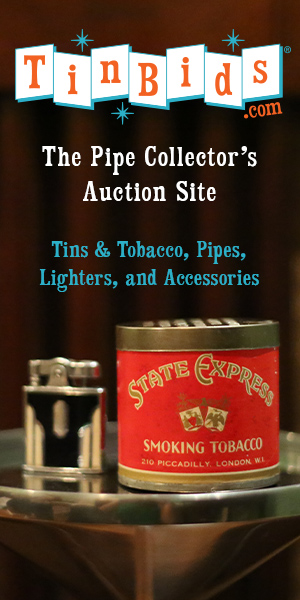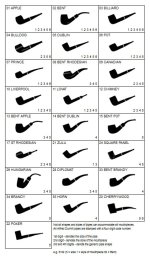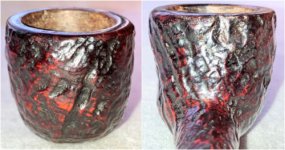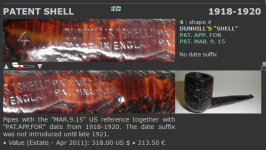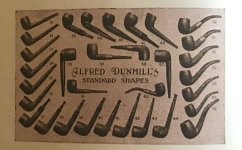This is becoming even more interesting. The late dates of the pipes George worked on seem to provide clear evidence that Loring was a bit arbitrary in writing "Once Dunhill began to make its own pipes it ceased offering shapes #s 1 - 30."
MCJ, thanks for the link to Pipephil. Here is the pertinent bit for me:
View attachment 176054
I, too, now have a no. 4, and am more at sea than ever. Is it truly a "shape 4", is it an Arabic numeric rendering of "IV"? Is it a mistake on the part of a tired stamper? The patent numbers seem to mandate a date for mine of 1918-21, but there's no date code.
It is a brave man--indeed one far braver than I--to suggest anything that John Loring wrote about pre-war Dunhill might have been "a bit arbitrary." Not only was John meticulous and methodical, my own sense was that he was absolutely delighted when anyone brought a new piece of the grand puzzle to his attention--a mistamped pipe, a curiosity of nomenclature, a symbol never or seldom seen. And he was extraordinarily open about both "known unknowns" and "unknown unknowns."
As for stray numbers stamped on early pipes in general--insofar as I know nobody has yet produced a single 1920s shell pipe with a roman numeral stamped on it.
If you read the catalogue prose of early editions of About Smoke with some care, I believe the most plausible interpretation of their initial marketing idea for shell pipes was that each was going to be
totally unique--unlike smooth pipes--and shape numbers were not really relevant. The use of roman numerals in the catalogue was to offer a few particularly handsome but representative examples of what a customer
might request--either in person at one of Dunhill shops or by mail order (something they clearly took great pride in, and went to ridiculous lengths to offer individualized service). And at least my interpretation is that they used roman numerals so that they would not be confused with shape numbers.
As is so often the case (at least in my own experience as a copywriter for ultra luxury brands a good deal more recently) there may well have been a fair amount lost in translation between what happened on the factory floor, who said what to whom in dealing with customers at Dunhill retail stores, and what the people writing a catalogue a season or two in advance of the launch of future or recently introduced products, regarding what they or their bosses knew or hoped would be the case.
My own theory is that nobody ever took the "totally unique" concept very seriously. And it was given up early in favor of the sort of language we use today--referring say, to an unusually craggy shell "56" or "120" or "LB." Or to those with fairly shallow blasts (which accordingly in the case of the latter conform very closely to specific shape numbers). This presumably reflecting what I infer must have been the factory's standard practice in how shell pipes were actually made--with raw stummels cut in one or another of Dunhills standard shapes.
As for stray arabic numbers on 1920s and pre-1920s pipes. There is plenty of room to speculate. My impression is that a fair number of us believe that in many cases they refer to the size of the specific innetube you were meant to order when the original one needed replacing.
As for whether any of the arabic numbers seen on early shell pipes denote shape numbers, again, my impression is the jury's still deliberating. And yes, to the original poster, if someone could produce a 1910 Dunhill pipe chart, that really would answer a lot of our questions.
But Loring--very much in the thick of it 25 years ago, with unrivaled access to Dunhill records, at a time when Dunhill still had a full time professional archivist, and one infers, when a certain number of very senior factory workers were still alive to talk about what wasn't part of the official story--doesn't seem to have located one.
If he had I'd have thought it would have been included in either his Briar Pipe booklet or one of his multi-volume xerox compilations of catalogues. I have to admit I've lusted after a pdf of the latter for as long as I can remember, but I've never met anyone who owns all the volumes. And the few times I've seen a complete set for sale, the price has been well beyond my means.
Apologies to all for rattling on at such length.




